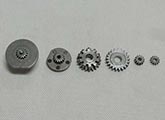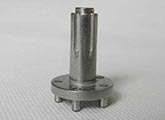Metal Injection Molding Surface Finish
The surface finish for metal injection molding components are typically 32µin Ra (as sintered). In order to achieve a better surface finish and enhance the physical properties of these components, various secondary processes can be applied, ranging from grinding and polishing, to tumbling and chemical surface treatments.
 |
 |
 |
An injection molding surface finish process may be necessary in cases where the removal of gate marks, parting lines or ejector pin marks are required. In some cases it is possible to remove these features in the ‘as molded’ state.
In cases where the removal of features in the ‘as molded’ state is not sufficient, more precise material removal processes will be required. To achieve a surface finish for metal injection molded parts that are larger in size, hand held finishing techniques using soft grinding wheels are commonly employed.
Vibratory vessels using abrasive materials can also be used to smooth the surface finish. Note however that these vibratory techniques are not sufficient in removing parting lines or ejector pin marks.
Metal Injection Molding (MIM) materials can be be readily plated or undergo other surface treatments using standard processes such as those used on wrought materials. With MIM surfaces, there are no special requirements in terms of pretreating surfaces before undergoing surface treatments.
- Chemical Surface Treatments
- Heat Treatment
- Mechanical Surface Treatments
- Metallic Coatings
- Organic Coatings
- Physiochemical Surface Treatments
- Wear Resistant Coatings
Chemical Surface Treatments
These treatments includes etching, pickling, burnishing and chemical deburring.
Heat Treatment
Done in order to increase the components strength, resistance to wear and hardness. Processes here include tempering, case hardening, quenching followed by tempering, surface hardening.
Mechanical Surface Treatments
Processes here include shot peening, engraving, polishing, barrel finishing, deburring and grinding.
Metallic Coatings
In this category, chromizing, electroplating, metal spraying, chemical metal coating and melt dip coating techniques are used.
Organic Coatings
Organic coatings for MIM components include adhesive bonding, printing and varnishing.
Physiochemical Surface Treatments
Treatments here includes siliciding, nitrocarburizing, nitriding and boriding.
Wear Resistant Coatings
Wear resistant coatings applied includes PVD coating and CVD coating.
Back to Main Page: Metal Injection Molding
Further Suggested Reading:
- Materials used in Injection Moulding
- Metal Injection Molding Tolerances
- Metal Injection Molding Wall Thickness
- The Metal Injection Molding Process
